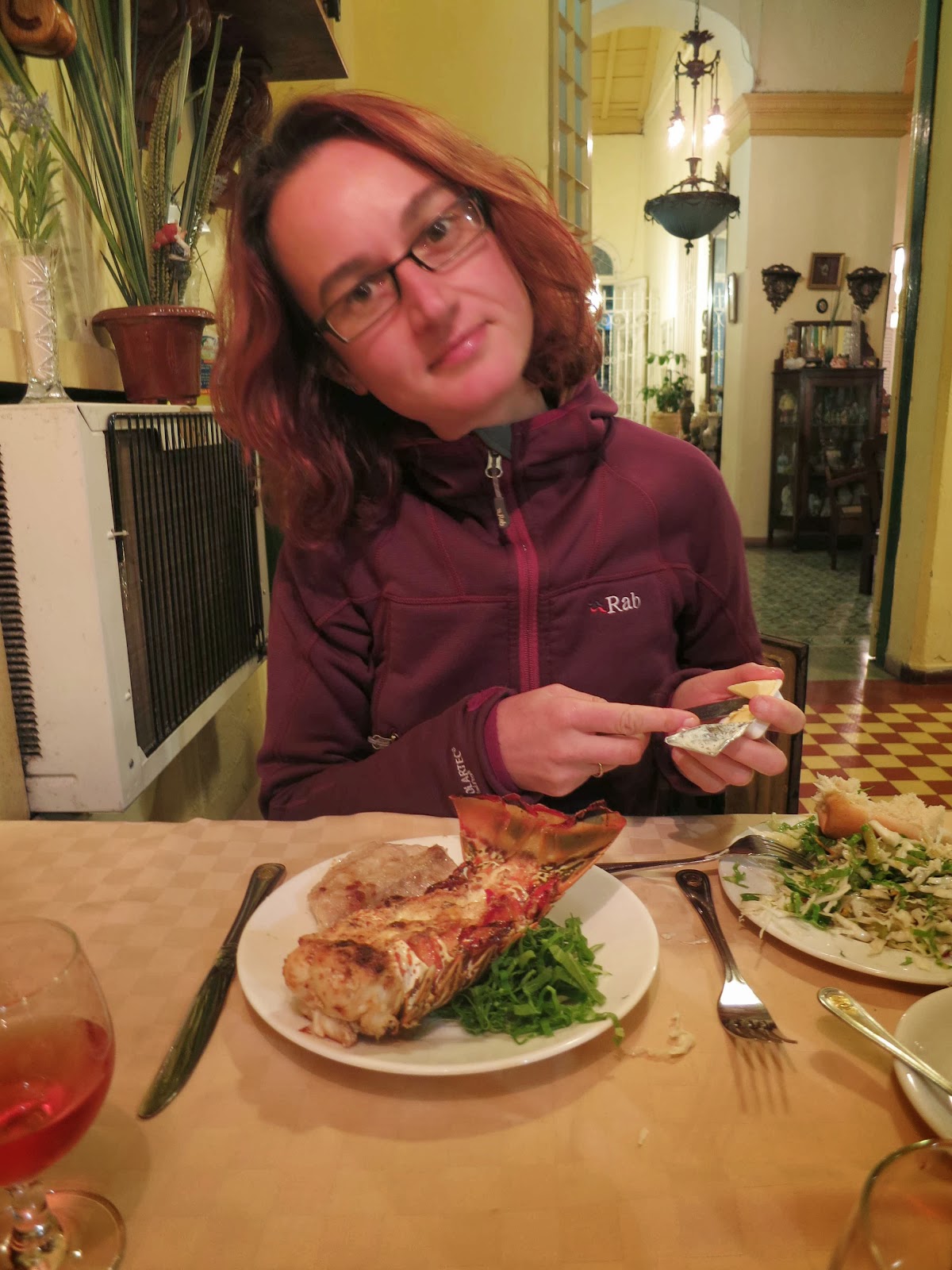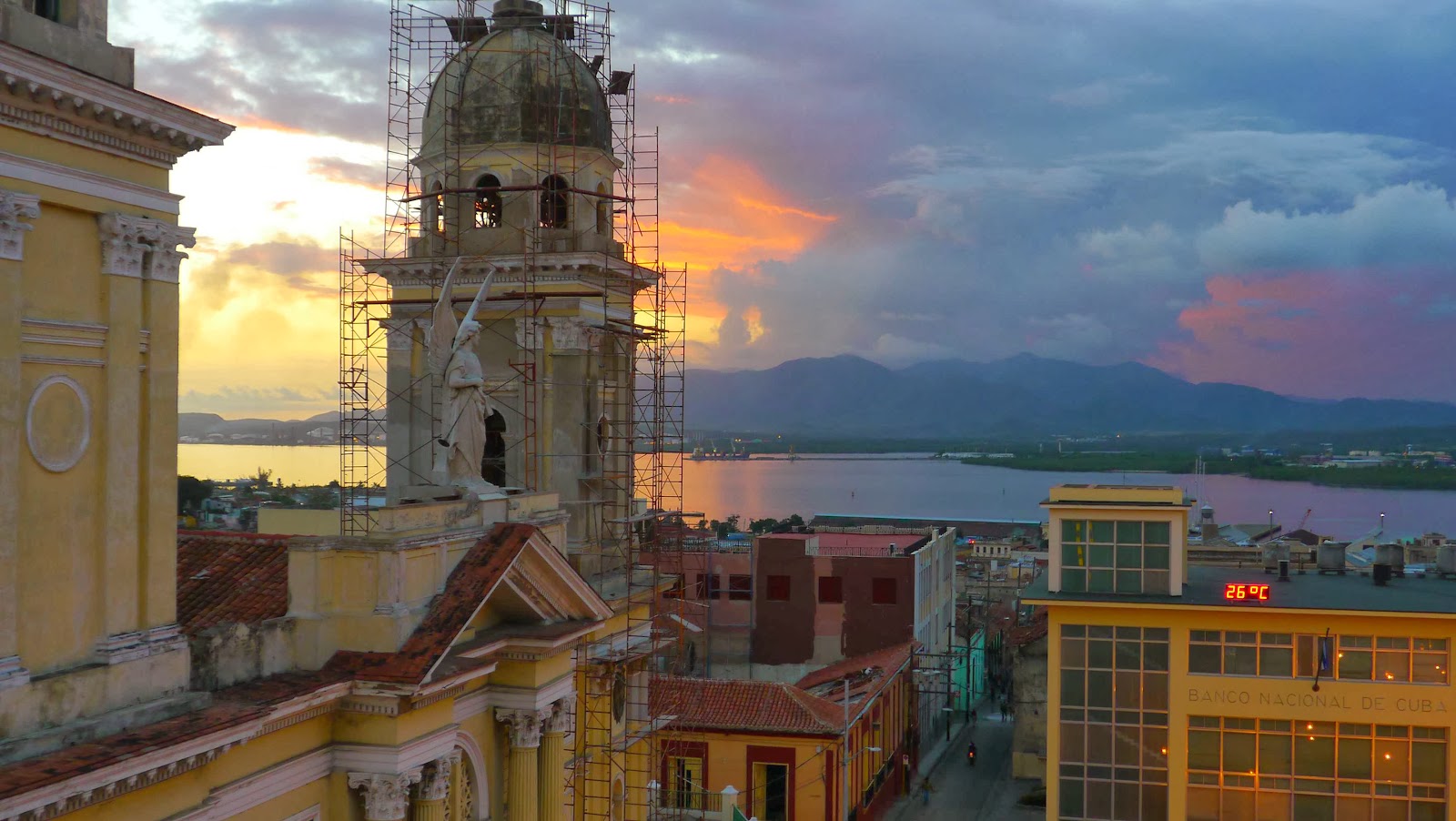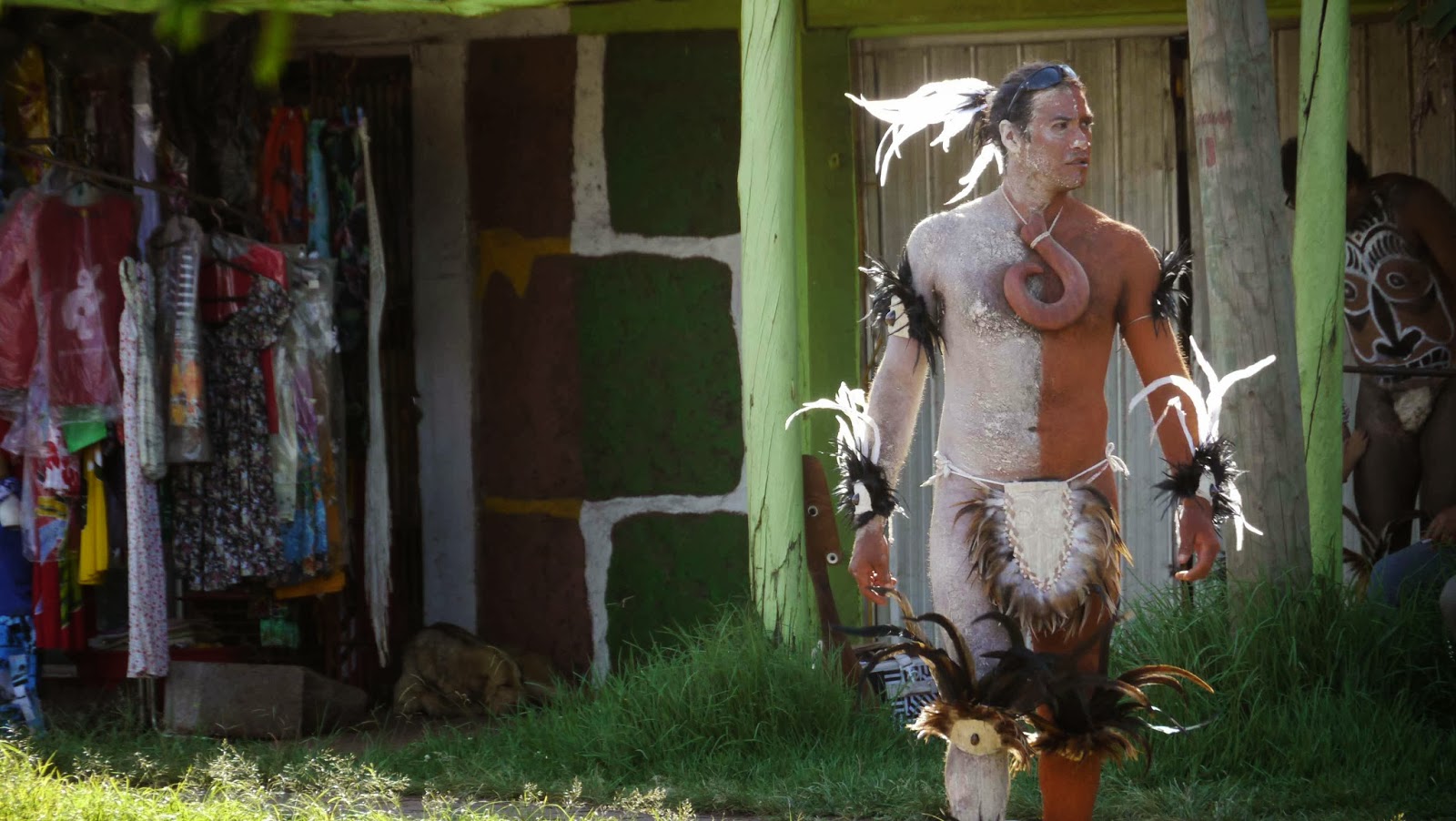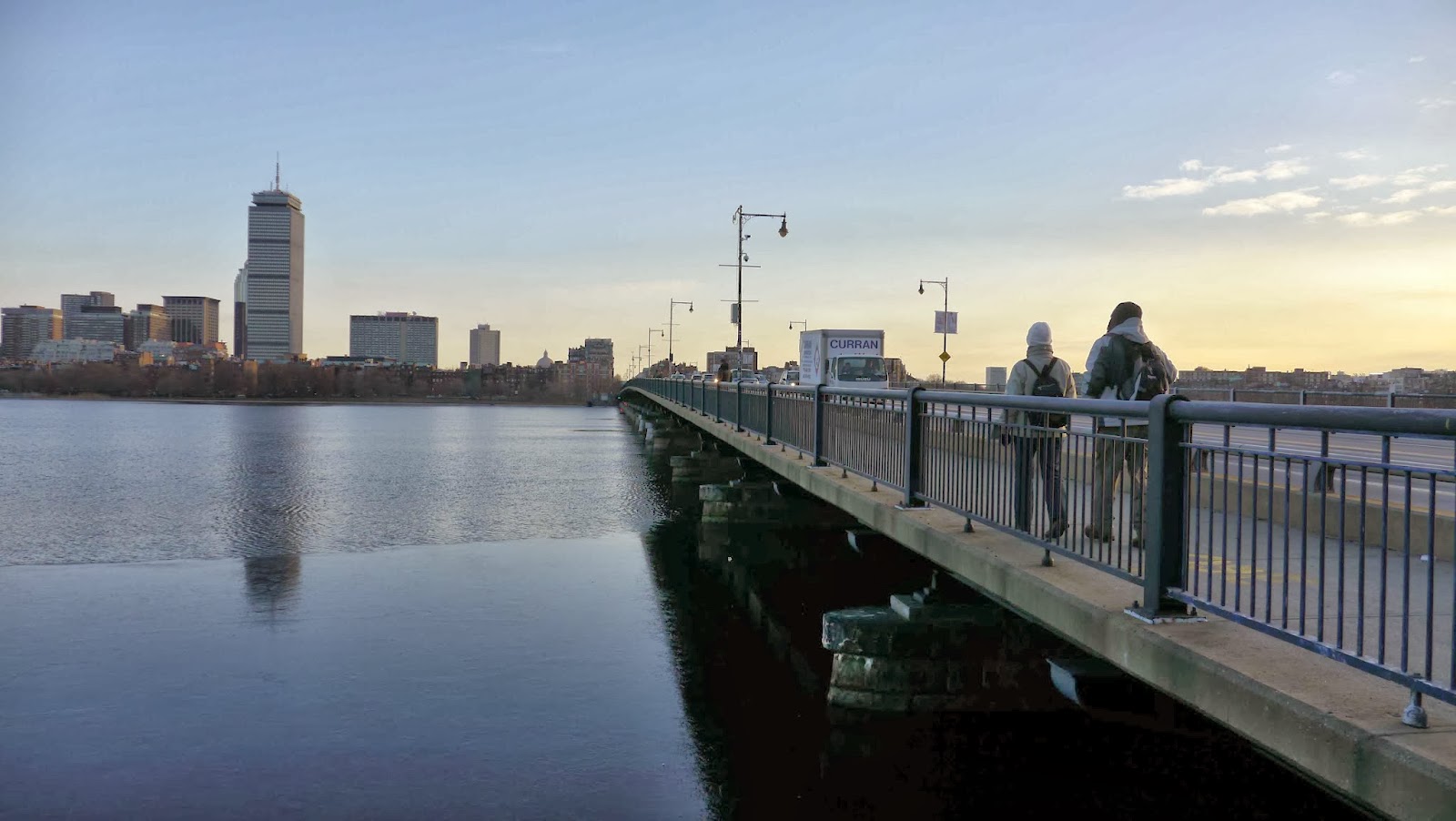Cuba: Town by town
Drove to Santa
Clara – a big town that was the first to be “liberated” by the
rebels in the revolution. Nice town, pretty plaza, nice restaurant
(am currently testing to see if there's a limit to how much lobster
and prawns you can eat before tiring of it), nice casa, cheap beer,
good people-watching. Also, conveniently for folksong writers, Santa Clara rhymes beautifully with Che Guevara.
Took a day trip to a resort on the coast. There's a scattering of big resorts all over the island for Canadian tourists who arrive by the planeload (50 flights a week from Canada into one particular resort!). It was nice to be back by the sea, in a tropical climate (though a chilly winter cold snap), with geckos and palm trees and mangroves. Karl had a swim, I chickened out.
 We gatecrashed the resort Jacuzzi. Once you look vaguely like a Canadian tourist you can do anything.
We gatecrashed the resort Jacuzzi. Once you look vaguely like a Canadian tourist you can do anything.
After Santa
Clara headed to Camaguey. Now the guidebook described the streets of
this town as laberynthine. It said more than once that you'd be crazy
to try to navigate them by car and that part of the joy of exploring
the town as a pedestrian is getting lost in it. But we drove in
anyway. How bad can it be? I had a map and a compass. Easy.
Bloody
nightmare. It's all narrow, wiggly little streets like Europe. All
streets are one way but the map doesn't mark them so it's a surprise
(yay!) at each junction. The map has the “new” streetnames but
the streets have a random selection of “old” and “new” and
completely missing names. So you go 'round and 'round and 'round,
circling near your destination but always prevented from reaching it
by a little one-way arrow pointing the wrong direction. It's like the
most frustrating puzzle you've ever tried but you can't give up.
Anyway, in the end we parked a block from the casa and retrieved the
owner to direct us there. Felt a lot better about my navigation
skills after seeing the route we then had to take to get to the casa
from only a block away.
 Great little bar with the world's wobbliest barstools - a good test of if you're sober enough to order more.
Great little bar with the world's wobbliest barstools - a good test of if you're sober enough to order more.On foot Camaguey's great. A mix of colonial and art deco architecture (and art decofied colonials), pleasant plazas, excellent mojitos. Had been keeping our eye out for an electric kettle (always like to travel with one for that first coffee of the morning before you've worked up the enthusiasm to face the world) and couldn't find any until Camaguey in a department store. Only took 35 minutes to buy (so quicker then car hire). This involved painstakingly taking the kettle out of its wrappings, plugging it in, turning it on to prove it worked and wrapping it back up again. Then just a few forms to fill out and ID details taken. Then over to the cash register. Then security on the way out need to check that the contents of the bag match the receipt. I think this may be the solution to overspending. While examining the kettle at the counter it attracted some interested locals wondering what this gadget was. They moved quickly from vaguelly impressed to “so it just heats water”. Ditto reaction from a couple of our casa owners. I don't think the electric kettle is going to catch on here.
To Holguin. The beer-brewing capital of Cuba. They brew at least four different bland lagers here, all of which hit the spot exactly in the middle of a hot, humid day of sightseeing. An ordinary kind of town but pleasant. Nice pedestrian street slightly reminiscent of small, recently rich Russian towns.
Excellent food though. I keep stressing the food but the last time we were here the food was so bad I have no memories of it except for a particularly awful pizza at our favourite bar. We never risked following the people who whispered “lobster” at us in the street. In the last couple of years the regulations on small private restaurants have changed. Previously you could have a maximum of 12 seats, could only employ family and could only serve certain food. Now you can have up to 50 seats, employ non-family members and serve whatever you like – hence my current seafood-and-fruit diet. So the small, privately-owned restaurants (paladares) are increasing hugely in number and quality.
Santiago de Cuba
The southern capital – second largest city in Cuba, longstanding important trading port for the Spanish and target of pirates, corsaires and the like. Distinctly different atmosphere from the towns in the central part of the country and feeling more like La Habana – hot, loud, crumbly, life tumbling out on to the street. The middle of the country is much quieter, more sedate, more European and with a very high white/criolla population. Santiago starts to feel like the Caribbean again.
Although despite the bustle, the further east you get, the more Queenlander they become (it gets hotter and more humid). The name of the game here is minimum effort. A typical conversation with our casa owner:
Is there an ATM
near here?
Yes.
Where?
4 blocks away.
In what
direction?
She points
vaguely, looking exhausted
Wandered around the hilly streets, down the the port, back up again.
Sat and
people-watched over a beer. Lots of middle-aged European men in the
company of young, attractive, local females. Also quite a bit of
showing of photographs, negotiations with more senior local men or
women followed by the production of a young local female,
congratulatory handshakes all around and then the couple are left to
their own devices. In fairness to the middle-aged European/Canadian
men we also saw some unlikely-looking couples consisting of
middle-aged European/Canadian women and young, attractive, local
males.
 Karl with our favourite hotel. Downstairs terrace for breakfast or afternoon drinks. Rooftop for evening cocktails. As seen in Graham Greene's Our Man In Havana.
Karl with our favourite hotel. Downstairs terrace for breakfast or afternoon drinks. Rooftop for evening cocktails. As seen in Graham Greene's Our Man In Havana.Baracoa
Right out on almost the most eastern point of Cuba, Baracoa is one of the original settlements from 1514 but still a small, sleepy coastal town that never really grew and was only joined to Santiago by road in the 60s. They also got a chocolate factory in the 60s thanks to Che. The local hot chocolate is a fantastically thick, rich brew with a hint of alspice (or maybe nutmeg?). Alas no accompanying churros.
To get there travelled through the Guantanamo region (responsible for two of the worse atrocities of the modern world - the US detention base and the song "Guantanamera"), a very dry, deserty coastal area.
A small-town
feel but with a nice new (and still a work in progress)
pedestrianised main street, colonial buildings, shady plaza. We
arrived on a lazy Sunday afternoon and it reminded me of Tuam on a
lazy sunny Sunday (that one we had once). Then a fight broke out.
Now there's nothing to do here, after the 10 minutes you've spent strolling the malecon, but chill out and people-watch. So we did.
We've found a good use for fancy-schmancy hotels. They tend to have roof terraces that are the highest point in town and serve cocktails around sunset. In fact for some bizarre reason their happy hour (or two) tends to coincide with sunset. So: view over the rooftops, gentle breeze, sunset, $1 mojitos....what could go wrong? Baracoa's fancy hotel is only one storey tall but built on top of a hill and its pool terrace overlooks a beautifully curved, tropical bay.
 Such a typical Cuban scene - father teaches son how to fix whatever piece of machinery they have and friend is welcomed for advice or as looker-onner.
Such a typical Cuban scene - father teaches son how to fix whatever piece of machinery they have and friend is welcomed for advice or as looker-onner.Writing this while chilling in the garden of our casa with a bottle of white while Karl rocks to and fro in his rocking-chair, evil-villain-like, stroking a cat.
Las Tunas
Trinidad
Brilliantly preserved colonial town (thanks to UNESCO) with a permanent stream of tourists wandering through. Another of the original 1514 settlements. Remained a relatively undeveloped hideout for pirates until, in the 19th century, the French fleeing the slave rebellions in Haiti started growing sugar cane around here, made a truckload of money and built huge and fabulous homes in town. The canefields were ruined in the war of independence in the late 19th century so development in the town stopped. So now it's a little time capsule complete with real cobblestone (very uneven, concentration required when walking, a good workout for the feet and calf muscles, a great test of Car-Car's suspension) streets. Yes, Karl has read Mark Vonnegut and named our car.
The centre, though gorgeous, is a bit too unreal. For a few blocks every single building is either a bar, paladar or casa particular and the ratio of shiney white tour groups to locals is very high. But just a couple of blocks away from that the streets still have those damned cobbles, the buildings aren't quite so perfect and people actually live in them, the horse and carts are doing actual work and it's still got a lovely chilled vibe about it.
Also good rooftop terraces but expensive cocktails. And a view all the way to the coast at sunset.
La Boca
Karl's been bleating on for a while now about finding his romantic, small, coastal town (he's just read The Old Man and the Sea) to spend a few days doing nothing (or at least less than usual). After many fanciful plans received the Kara veto we decided that maybe the coast near Trinidad was the place to go (as opposed to the various keys off the north coast or the big diving spots over West). So we've found a quiet casa by the water just outside a wee little village (big enough to have a couple of bars, a tiny shop and a couple of food stalls) down the road from a decent stretch of beach.
Yesterday we “went to the beach”. Like properly. Got there shortly after nine. Hired a couple of sunloungers underneath a thatched parasol. Watched as the guests from the surrounding hotels arrived and set up camp. Read a bit. Had a bit of a swim (in proper greeny-blue Caribbean water with slightly coarse but properly pale sand). Read a bit more. Got served beer and food by a wandering waiter. Had a bit of an oul' relax. Great. Mini beach holiday. Karl even got proper Irish sunburn. It's like a football strip – bright pink with a white stripe across the middle from where he was holding his book.
Then retreated
to our terrace overlooking the sea and just kindof sat. And had some
wine. And sat some more. And that's where I am now. Just sitting on
the terrace having finished breakfast on the terrace. Cat-Cat
snoozing beside me (you see the Karl naming things pattern?). Karl
having a bit of an oul' read and a cuppa. Waves gently lapping out
front. Last night you could see the lights from little fishing boats
(as we sat on the terrace with some rum).
Cienfuegos.
Interesting town, Cienfuegos. Founded in the 19th century by French fleeing the slave rebellions in Haiti. French town-planning. In the centre Parque Marti (not “Plaza” mind you, “Parque”) lined with very impressive neoclassical buildings – the town hall, the theatre, a school, mansions of the sugar barons. Wide streets in a grid system, a long prado with a tree-lined footpath down the middle of the car lanes. A seaside suburb with an intriguing mix of 19th century mansions and 20th century modernists houses (well done modernism, I'm guessing these were the people who weren't in favour of the revolucion). 19th Century “Club” on the bay for yachts, tennis, swimming and drinking cocktails on the terrace, dahling. Not sure exactly how this fits into the socialist, worker's paradise but maybe it's only foreign tourists who have to pay to use the facilities....
Now, Cienfuegos is not my favourite Cuban town. On paper it sounds great. But it's just a bit too gritty, too run-down, too battle-hardened (and smelly when it rains). I imagine it just hasn't had quiet the economic or social benefits of other towns, maybe all the angry rejects came here.....
It does however have a fancy-schmancy hotel. The rooftop terrace wasn't open yet when we went there for cocktails (are we drinking too early in the day?) but the pool terrace certainly was! I have recently realised that I genuinely may have drank more cocktails in the past couple of weeks than in my entire life up to this point. I've realised that pina coladas can be really yummy. I'm a little bored by mojitos (though I'm drinking one right now and it's rather good). The Havana Club Especial is very good. And I've got to get myself a bottle of maraschino liquer for daiquiris.
Vinales
We've come back west to explore the tobacco growing region. Vinales is a very small town founded in the late 19th century in the middle of an impressive landscape of eroded limestone hills and flat farmland.
And as we were driving up from the motorway......tobacco!!!!!!
Never seen tobacco growing before. It's very green and very leafy. Occasionally there are lines of bunches drying on wooden racks like the Norwegians dry cod (see Karl's Norway Flickr photos of Lofoten). Also, recently smoked a cigar we had been given by a restaurant at the end of a meal. Now this was always going to be a cheap cigar but interestingly – it still had a nice taste, but the draw was terrible, loads of air going through. And I noticed this! I'm a cigar expert!
This is a very relaxing kind of place. Front porches with rocking-chairs seem to be mandatory. The entire population just sit, rocking gently, every evening, side by side, like a gigantic, outdoor sitting room. Right now I'm on a front porch, rocking in a rocking-chair, sipping a mojito.
Lots of extremely cute little cottages dotted through the countryside.
Had a daytrip to the beach. On the north coast there's a beautiful key. Had a bit of an ould admire, a bit of an ould swim and a bit of an ould cocktail.
 Karl at the most beautiful beach (or even thing!) that he's ever seen in his life. Partly due to polarised sunglasses methinks.
Karl at the most beautiful beach (or even thing!) that he's ever seen in his life. Partly due to polarised sunglasses methinks.Bid farewell to Cuba with a final few cocktails in La Habana. And onto Easter Island.





















































Comments
Post a Comment